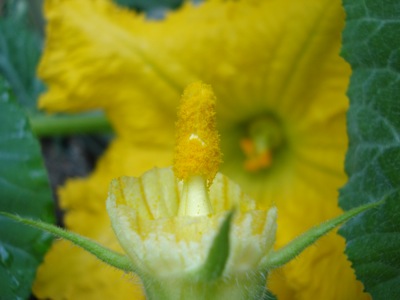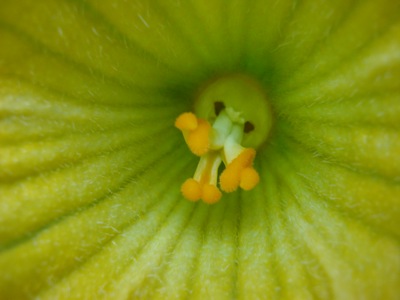Pollination
Vegetables that are eaten past the flowering stage rely on proper pollination. If there’s a problem with this vital process, vegetable production will suffer.
Below are descriptions of vegetables that rely on pollination, the pollination method they use, and possible problems and solutions.
Squash – Squash plants have male and female blossoms on each plant. The females will have a small squash behind the flower, the males will just have the long thin stem. If pollen is not transferred from the male flower to the female, the little squash will not grow completely, and will eventually rot from the tip. To get the best squash, pollination should occur right after the flowers open.
Squash are pollinated by bees. At the beginning of the season, pollination may not occur if the bees have not yet found the flowers. In this case, one can hand pollinate the squash.

Simply pluck a male flower and remove the petals. You will see yellow pollen on the stalk that’s left.

Touch the pollen to the tip of the female stigma, which is at the center of the female flower. You will have enough pollen on the male flower to pollinate a few female flowers. This hand pollination should be done when the temperature is above 55 degrees F, otherwise the pollen may be damaged.
Cucumbers – The pollination process for cucumbers is the same as for squash, except all the “parts” are much smaller. It’s much harder to hand pollinate cucumbers.
If your plant has produced too many cucumbers, all of them may not pollinate. I have had this problem with pickling cucumbers. In this case, pick some of the small fruits and toss them onto the compost heap.
The are parthenocarpic varieties of both squash and cucumbers. This means that they set fruit without needing pollination. These parthenogarpic varieties are especially useful in greenhouses, hoophouses, and under row covers.
Melons are also pollinated like squash. And they also have very small flowers. I have never had problems with pollination of melons. I don’t know of any varieties of melon that don’t need pollination.
Peas, Okra, and beans do not need pollination. Runner beans are one exception; they require pollination.
Tomato and pepper flowers have both male and female parts. They pollinate through a very gentle shaking. Usually the wind is enough to perform this vital task. If you are planting indoors or in a greenhouse or hoophouse, tapping the flowers gently will do this shaking. One or two light taps on each cluster of blossoms is sufficient. Do this every few days to pollinate all of the flowers. Electric vibrating gadgets are not necessary, except maybe for a large-scale operation.
Eggplants – many varieties are self-pollinating. If your eggplants aren’t growing, you can try the tomato tapping method . If these methods don’t work, try knocking some pollen from a male flower onto your finger and deposit it on the female flowers.
Corn relies on the wind for pollination. Corn pollen is produced in the tassel at the top of each stalk. When the wind shakes the plant, pollen falls from the tassels onto the silks, which are the plants’ female flowers. Each silk that is pollinated results in a kernel of corn developing on that ear. To provide this maximum wind pollination in an area, corn should be planted in blocks rather that in long straight rows.
Pollen of a given plant rarely fertilizes the silks of the same plant. Its been reported that s 97% or more of the kernels produced by each plant are pollinated by other plants in the field. Because wind can carry pollen up to a mile or more, pollen from one variety can pollinate anther variety unless there is great distance between the plants or unless your variety choices are ones that do not pollinate at the same time. Since corn is a seed, it may affect the flavor of the cross-breed.
The amount of pollen is rarely a cause of poor kernel set. Each tassel contains from 2 to 5 million pollen grains which translates to 2,000 to 5,000 pollen grains produced for each silk of the ear shoot. Shortages of pollen are usually only a problem under conditions of extreme heat and drought. Poor seed set is more often associated with poor timing of pollen shed with silk emergence (silks emerging after pollen shed). Under good conditions, all silks will emerge and be ready for pollination within 3 to 5 days and this usually provides adequate time for all silks to be pollinated before pollen shed ceases.
Saving your own seeds
If you are growing “open-pollinated” varieties (vesus hybrids), and wish to save your seeds, cross-pollination must be prevented so that plants produce pure seeds. Pollen from other varieties must be excluded from reaching your plant’s flowers. If another plant’s pollen does reach a variety, it will not affect this year’s fruits. You will still get the variety you expected. It’s the seeds that will be affected.
One way to prevent pollination is with a lightweight row cover. This row cover will also help protect crops from insect pests. It allows 90% light transmittance and gives a minimal heat increase during the day. Water and light permeate this cover. It will last two or more seasons, depending on care.
Pollinators
Honeybees are the most efficient pollinators . They have hairs on their bodies, and when they brush against the anthers of flowers, pollen collects in these hairs. When its body is covered and moves to a female flower, some of the pollen drops. Honeybees normally forage within ¼ mile of their hive. If nectar and pollen are scarce, bees will travel up to three miles.
Bumblebees, Sweat bees, and Wild Solitary bees pollinate the same way as honeybees, but aren’t as reliable or as efficient. Moths and butterflies are inefficient pollinators.


